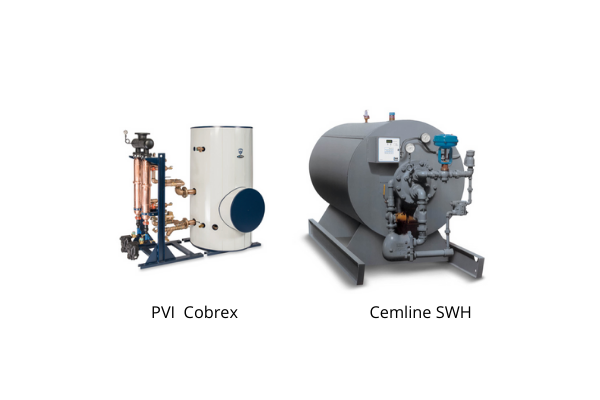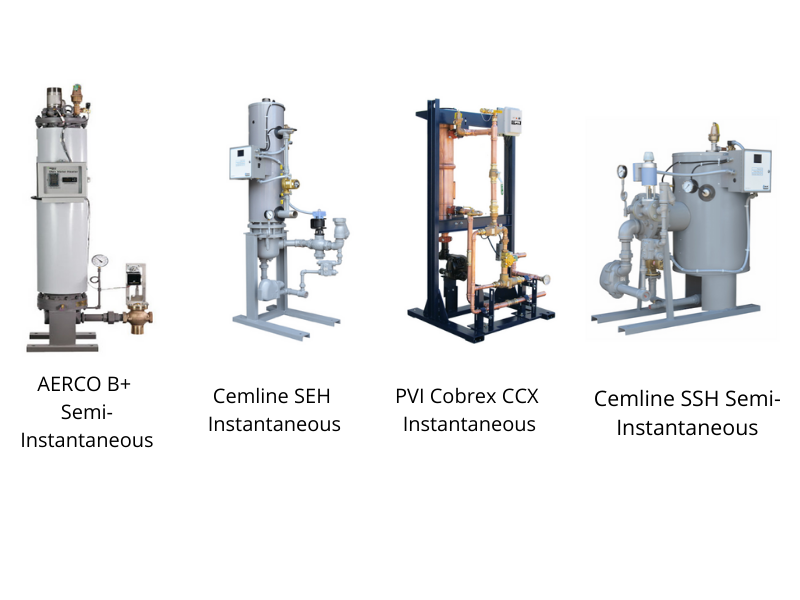 The engineer contacts us for assistance in selecting an indirect steam source water heater. Do you need a lot of storage, a small amount of storage, or no storage? The answer is a match between the source, the heater, and the load.
The engineer contacts us for assistance in selecting an indirect steam source water heater. Do you need a lot of storage, a small amount of storage, or no storage? The answer is a match between the source, the heater, and the load.
Storage vs. Instantaneous Steam Water Heaters
There are three types of water heaters using steam as the heat source: storage type, semi-instantaneous, and instantaneous.
STORAGE WATER HEATERS
Long ago, in a galaxy…OOPS. Wrong story! Long ago in the world of plumbing, storage type water heaters were the vehicle to produce domestic hot water using steam as the source. The storage was used to prevent a lazy control system from sending too hot a temperature out to the users. Today, the control valves, mixing valves, and control technology is much better. As a result, most steam water heaters are instantaneous or semi-instantaneous. 
INSTANTANEOUS AND SEMI-INSTANTANEOUS WATER HEATERS
Steam sourced storage water heaters are used when the hot water load may be greater than the steam production capability when other uses, such as building heating, are at design. This does happen, but not very often.
It is interesting in the world of the American Society of Plumbing Engineers (ASPE) gas fired water heaters with little or no storage are referred to as tankless. The same publication from ASPE refers to a steam source water heater with the same small storage capacity as instantaneous.
I am not aware of a clear definition of what makes these “tankless” water heaters instantaneous or semi. I am also not concerned about it. Here are a few examples of water heaters and the title given them by the manufacturer. Here is a link to our plumbing water heater website in case you want to read a bit more about them.
In general, the instantaneous water heaters have the steam in the shell and water in the tubes. Most semi-instantaneous water heaters are the reverse. But look at the Cemline SEH. It has steam in the tubes. My best explanation is that the semi-instantaneous has a small storage of 30-100 gallons while the instantaneous have less than 10 gallons of storage.
Where would you use one or the other? Start by recognizing that all these heaters are sized on gallons per minute (GPM) methods, not gallons per hour (GPH). The storage type water heaters are sized using the recovery rate or GPH. All the control valves used are mechanical. Whether the control is electronic or pneumatic, the valve must still respond to the signal. If the load changes a great deal instantaneously, there is a chance the outlet temperature may rise some. Is there a volume of pipe acting like a buffer tank? Is there a ASSE 1017 master mixing valve or do all the fixtures have ASSE 1016 or other point of use mixing valves? These are all “tells” that you may lean toward an instantaneous unit.
Some small storage might be recommended if the design peak load calculations have some wiggle room that make you nervous. A small buffer for an unexpected peak may be in order. Another reason for some storage again focuses on the peak demand. There may be a peak demand that requires a volume of water at a high rate for a very short time. We may call this a dump load. This dump load would result in an oversized heater and oversized control valve for all the other loads. That 40–100-gallon buffer would result in a smaller water heater properly sized for most of the time.
Once the load and the type of water heater is decided, you will be asked about the steam pressure. This is the subject of the next R. L. Deppmann Monday Morning Minutes.


